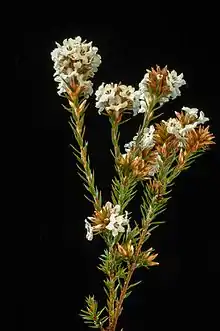Epacris lanuginosa
Epacris lanuginosa, commonly known as woolly-style heath or swamp heath, is a riparian angiosperm. Its conservation status is listed as 'Not threatened'.
| Woolly-style heath | |
|---|---|
 | |
| Woolly-style heath Photo courtesy of Rob Wiltshire | |
| Scientific classification | |
| Kingdom: | Plantae |
| Clade: | Tracheophytes |
| Clade: | Angiosperms |
| Clade: | Eudicots |
| Clade: | Asterids |
| Order: | Ericales |
| Family: | Ericaceae |
| Genus: | Epacris |
| Species: | E. lanuginosa |
| Binomial name | |
| Epacris lanuginosa | |
Description
The heath is a slender erect shrub that grows to a height of 60–90 cm or 90–120 cm, depending on its location.[1] It is often branched near the base, with crowded, spreading leaves that are narrowly linear-lanceolate to lanceolate in shape, 5-13mm long and 0.6-3mm wide. Its leaves are smooth, flat or concave, with the mid-vein upturned towards the apex beneath and obscure venation.[2] The leaves are hard and have are sharp point at the tip with a leathery feel.[3]
The woolly heath mostly flowers from late winter to early summer. When in bloom, small white flowers forming in dense terminal clusters along the upper 10 cm or more of branches. With 13–30 bracts and lanceolate sepals about 4.5–7.5mm long both brown with a papery texture. The corolla is white and tubular to narrowly bell shaped 4.5-8mm long, equal to or slightly longer than the calyx, with tiny white hairs internally, the petal lobes 2.7–4 mm long, obtuse; anthers enclosed within the corolla tube; ovary also finely hairy, nectary scales narrowly triangular, style slightly thicker and pubescent in middle third, 5.5–7.5 mm long.[4] Its fruit is a papery capsule. When the lower capsule on the stem has opened the capsules higher on the stem are ready to collect. Germination of the seed takes place under dark conditions and using heat shock combined with smoke and water treatments.[5]
 Epacris lanuginosa Photo courtesy of Rob Wiltshire
Epacris lanuginosa Photo courtesy of Rob Wiltshire
Habitat and distribution [5]
Common in southeast Australia Epacris lanuginosa is natively found in very few parts of NSW, Victoria across the south from predominately in; Glenelg Plain, Otway Plain, Greater Grampians, East Gippsland Lowlands and Wilsons Promontory. It is also found in evenly distributed across Tasmania, including all the islands that surround the state. It is abundant in wet heathland environments, from sea-level to 1000m. In wet scrub and in healthy forests, on poorly drained peaty soils that are moist and waterlogged.
Threats and conservation
Epacris lanuginosa is highly susceptible to the exotic fungal rot root disease Phytophthora cinnamomi. It is a water mould pathogen that can cause disease and death by impairing the plants physiological and biochemical functions where the roots are the primary site of infection. Although there is currently a threat abatement plan in place for the reduction of the pathogen, it has only recently been implemented and the heath is still vulnerable to contracting the disease.[6]
References
- "Woolly-style heath". Dave's Garden. Retrieved 22 March 2017.
- Brown, E.A. "Epacris lanuginosa". PlantNET New South Wales flora online. Retrieved 22 March 2017.
- Plant Encyclopedia. "Epacris lanuginosa". The alpine garden society. Retrieved 22 March 2017.
- Vicflora. "Epacris lanuginosa". Royal Botanic Gardens Victoria.
- Smith, A. "Communities". Understorey Network.
- Schahinger, R; Rudman, T; Wardlaw, T.J (2003). "Conservation of Tasmanian Plant Species & Communities threatened by Phytophthora cinnamomi". Strategic Regional Plan for Tasmania. 03 (03).